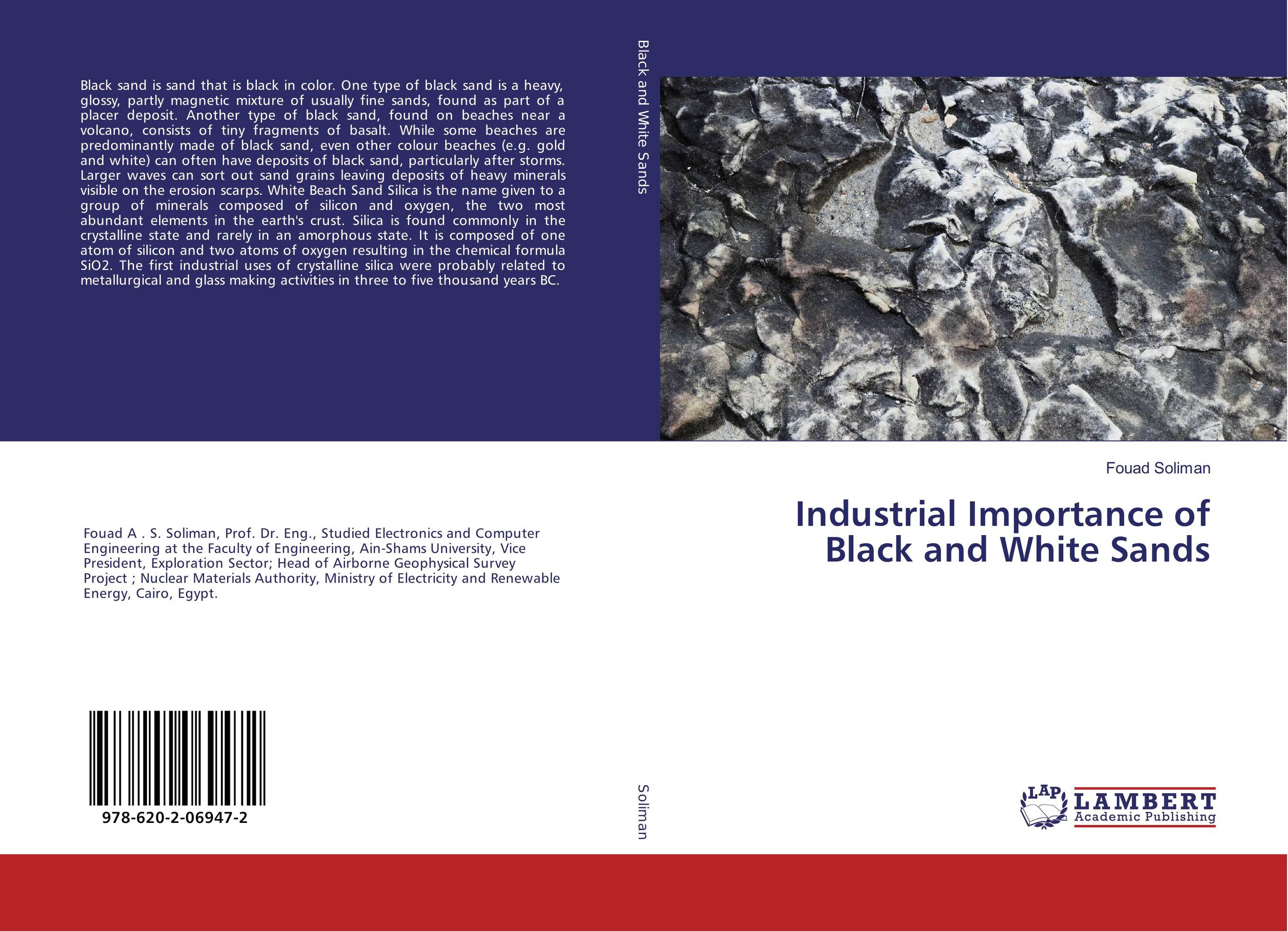| Поиск по каталогу |
|
(строгое соответствие)
|
- Профессиональная
- Научно-популярная
- Художественная
- Публицистика
- Детская
- Искусство
- Хобби, семья, дом
- Спорт
- Путеводители
- Блокноты, тетради, открытки
Industrial Importance of Black and White Sands.

В наличии
| Местонахождение: Алматы | Состояние экземпляра: новый |

Бумажная
версия
версия
Автор: Fouad Soliman
ISBN: 9786202069472
Год издания: 2017
Формат книги: 60×90/16 (145×215 мм)
Количество страниц: 132
Издательство: LAP LAMBERT Academic Publishing
Цена: 33510 тг
Положить в корзину
Позиции в рубрикаторе
Сферы деятельности:Код товара: 180466
| Способы доставки в город Алматы * комплектация (срок до отгрузки) не более 2 рабочих дней |
| Самовывоз из города Алматы (пункты самовывоза партнёра CDEK) |
| Курьерская доставка CDEK из города Москва |
| Доставка Почтой России из города Москва |
Аннотация: Black sand is sand that is black in color. One type of black sand is a heavy, glossy, partly magnetic mixture of usually fine sands, found as part of a placer deposit. Another type of black sand, found on beaches near a volcano, consists of tiny fragments of basalt. While some beaches are predominantly made of black sand, even other colour beaches (e.g. gold and white) can often have deposits of black sand, particularly after storms. Larger waves can sort out sand grains leaving deposits of heavy minerals visible on the erosion scarps. White Beach Sand Silica is the name given to a group of minerals composed of silicon and oxygen, the two most abundant elements in the earth's crust. Silica is found commonly in the crystalline state and rarely in an amorphous state. It is composed of one atom of silicon and two atoms of oxygen resulting in the chemical formula SiO2. The first industrial uses of crystalline silica were probably related to metallurgical and glass making activities in three to five thousand years BC.
Ключевые слова: algae, Almandine, Alzheimer's disease, Amphibolite, Applied, Basalt, beaches, blue, Brain, BROWN, Calcium Carbonate, catalysis, Caves, clams, color, Comparison, competitors, concentration, Conglomerate, contrast, copper, Coral reefs, Corals, crystal structure, crystallization, Dead Sea, Diamagnetic, diatoms, Divalent, EARTH, Electron Beams, Exoskeleton, Feldspar, Ferrimagnetic, foraminifera, Gamma-Rays, garnet, Garnets, Gemstone, Genesis, glass, Grains, Granite, Gravel, green, Gypsum, heavy load, Heavy Mineral Sands, hornblende, Igneous, Ilmenite, important, Iron, iron oxides, irradiation, Latitude, lithium, Magnesium, Magnet, magnetite, marble, Marine, marine organisms, mature, Metamorphic rocks, Mica, Microscope, Mineral, Minerals, Nanoparticles, Neurodegenerative diseases, Nuclei, Oil pollution, olivine, One, Organisms, paleomagnetism, Permanent Magnet, phase, Pink, Planktonic, Plate tectonics, polarizing microscope, Polymorphs, potassium, pyroxenes, quartz, Quartzite, rare, RED, relatively, Resistant, Restricted, Rivers, Rutile, saline, sand, Sandstone, science, sodium, Solid solutions, Substance, Temperatures, Tourmaline, transition, transparent, understanding, using, Verwey transition, volcanic ash, Volcanism, weathering, widespread, YELLOW, Zircon, coral sand, light-colored, calcareous fragments, biogenic origin, pink color, foram species, echinoids, latitudes, mollusks, sea urchins, aglae, sponges, reef-builders, colder water, glassy froth – pumice, amphiboles, dacite, silicic volcanic rock, silicic magma, polymerized, huge garbage dump, beach sand, immature sand, ultra-resistant minerals, evolved, evaporate mineral, sand grains, ooids sand, rounded accretionary mineralized bodies, crystal-lization, freshwater lakes, caliche soils, silica or silicon dioxide, cristobalite, tridymite, ameoboid protozoam, siliceous shells, siliceous, chalcedony, cryptocrystalline quartz, black sand, dark sand grains, volcanic minerals, lava fragments, volcanic glass, predominantly pyroxenes, augite, light-colored sands, green olivine crystals, reddish, light-colored quartz, lithic rock fragments, epidote, staurolite, greensand, mineral glauconite, deserts sand, huge areas, desert sand, lithic sand, chert, schist, phyllite, mixed carbonate-silicate sand, hybrid carbonate-silicate sand, biogenic sand, bone fragments, creatures, carbonate material, sea snails, silicate rock-forming mineral, garnet-bearing sand, garnet schist, rarely eclogite, aluminum-rich granite, olivine sand, volcanic sand, pyroclastic sediments, tephra, continental quartz-rich sand, pyroxene, magnetite characteristic minerals, hematitic sand, sandstones, volumetrically, devonian sandstones, detrital mineral, continental sand, biogenic grains, speckled, arenites, orthoquartzites, mineral grains, lithification, weathering cycles, black in color, andesite volcanic glass, light-colored quartzose sand, composed, moderately, crystalline boron silicate, mineral aluminum, semiprecious stone, schorl, sodium iron, endmember, dravite, brown tourmaline, sodium magnesium rich tourmaline end-member, uvite, calcium magnesium tourmaline, magnesium-rich, sodium-rich, lithium-tourmaline elbaite, pegmatitic minerals, tourmaline mineral, silicate minerals, ring cyclosilicate, iron-rich tourmalines, bluish-black, lithium-rich tourmalines, rarely, colorless, bi-colored, multicolored crystals, reflecting variations, fluid chemistry, pink inside, opaque black schorl, yellow tsilaisite, idiochromatic tourmaline species, magnetic susceptibilities, allochro-matic, tsilaisite, indicolite, blue gemstone, drag response, neodymium magnet, identified, paraiba, colored, magnetic blue tourmaline, manganese-containing near-colorless, pale pink stones, greatly, rubellite, Brazilian paraiba, clarity-enhanced, clarity-enhanced tourmaline, paraiba variety, worth, non-treated, granite pegmatites, granite pegmatite, magnesium-rich tourmalines, dravites, generally, schists, durable mineral, minor amounts, ZTR index, weathered sediments, main iron ores, attracted, magnetized, naturally-occurring minerals, Naturally-magnetized, ulvospinel (Fe2TiO4), hercynite (FeAl2O4), chromite (FeCr2O4), titanomagnetite, titaniferous magnetite, ulvospinel, crystallizes, serpen-tinization, lodestones, historic data, magneto-hydrodynamics, undergoes, monoclinic structure, cubic structure, significant air pollution hotspot, protein plaques, audio recording, magnetic acetate tape was developed in the 1930s. The German magnetophon utilized magnetite powder as the recording medium, industrial synthesis of ammonia, pyrope, spessartine, grossular, uvarovite, pyrope-almandine-spessartine, and uvarovite-grossular-andradite



